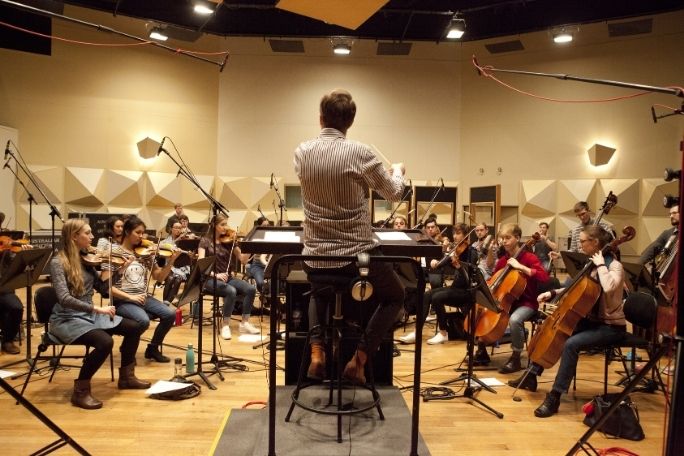Lesson summary
In this lesson, students will orchestrate the fanfare they have composed in previous Fanfare lessons. They will revisit the concept of Tone Colour to recall how musical instruments can create mood and feeling, then make instrumental choices based on how they intend their audience to feel. Students will then use notation software or hand write the instrumental parts for their own short 30 second attention grabbing piece of music which they can then enter into the Fanfare Competition.
Learning intentions:
Students will...
- understand how to orchestrate a piece of music
- understand why orchestration is important for their musical piece to come alive
- apply creativity to select instrumentation that reflects the mood of their Fanfare.
Success criteria:
Students can...
- understand the different sounds each instrument brings to an ensemble
- articulate the type of sound they want for their piece, and choose the appropriate instrument
- blend instruments together to create one sound that works well for their composition.
Lesson guides and printables
Curriculum links
Select your curriculum from the options below.
Lesson details
Curriculum mapping
Australian curriculum content descriptions:
Year 7 & 8 Music:
- Structure compositions by combining and manipulating the elements of music using notation (ACAMUM095)
- Experiment with texture and timbre in sound sources using aural skills (ACAMUM092)
Year 9 & 10 Music
- Improvise and arrange music, using aural recognition of texture, dynamics and expression to manipulate the elements of music to explore personal style in composition and performance (ACAMUM099)
- Manipulate combinations of the elements of music in a range of styles, using technology and notation (ACAMUM100)
Syllabus outcomes: MUS4.4, MUS4.5, MUS4.6, MUS4.7, MUS4.7, MUS5.4, MUS5.5, MUS5.6
General capabilities: Critical and Creative Thinking
Relevant parts of Year 7 and 8 achievement standards: Students manipulate the elements of music and stylistic conventions to compose music. They interpret, rehearse and perform songs and instrumental pieces in unison and in parts, demonstrating technical and expressive skills. They use aural skills, music terminology and symbols to recognise, memorise and notate features, such as melodic patterns in music they perform and compose.
Relevant parts of Year 9 and 10 achievement standards: Students interpret, rehearse and perform solo and ensemble repertoire in a range of forms and styles. They interpret and perform music with technical control, expression and stylistic understanding. They use aural skills to recognise elements of music and memorise aspects of music such as pitch and rhythm sequences. They use knowledge of the elements of music, style and notation to compose, document and share their music.
Unit of work: Artology Fanfare Competition
Time required: 120 mins.
Level of teacher scaffolding: High – to be able to deliver this lesson, you’ll require knowledge of instrument placement on a score and registers for sound. Transposing skills may also be required if notation software not available.
Resources required
- Student Worksheet – printed, one copy per student
- Device capable of presenting a video to the class, devices with notation software (such as Sibelius, Musition) – enough for one per student, whiteboard, manuscript paper, headphones, pencils and erasers.
Skills
This lesson is designed to build students’ competencies in the following skills:
- Communication
- Creativity
- Problem Solving
Additional info
This lesson is part of the Fanfare Competition unit. The unit is designed for students to build their aural and technical skills while exploring music as an art form through listening, composing and performing. Students are encouraged to apply their learning by planning and organising a composition for the Fanfare Competition.
The competition encourages young people aged 12‐21 years to write a new work to be recorded by the Australian Youth Orchestra and played in venues around Australia to replace the ‘cue bells’ for audiences to take their seats. It is a wonderful way to showcase young artists and musicians, and encourage creativity in young people.


Welcome back!
Don't have an account yet?
Log in with:
Create your free Cool.org account.
Many of our resources are free, with an option to upgrade to Cool+ for premium content.
Already have an account?
Sign up with:
By signing up you accept Cool.org's Terms and Conditions(Opens in new tab) and Privacy Policy(Opens in new tab).